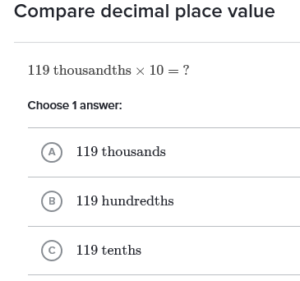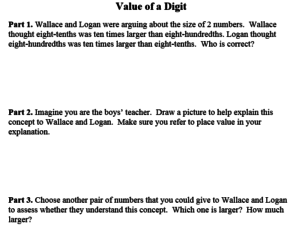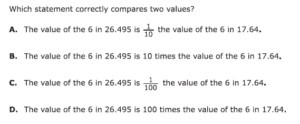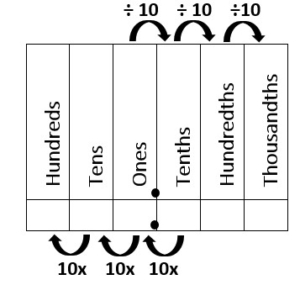Recognize that in a multi-digit number, a digit in one place represents 10 times as much as it represents in the place to its right and 1/10 of what it represents in the place to its left.
Students are able to…
- Compare values of digits based on their placement in a number.
- Use base-ten block manipulatives and models, such as a place value chart, to support students as they participate in discussions.
- Use tools such as money, playing cards, random number generators to compare values within decimals and whole numbers.
Students are able to…because teachers:
- Provide opportunities for students to determine the value of digits in different locations within a number through activities and games.
- Promote the development of conceptual understanding through models and tasks that require students to compare, identify, and describe digits in different places.
- Foster the use of base-ten blocks to build models in which the flat represents one whole, the long represents one tenth, and the cube represents one hundredth.
- Engage students in tasks comparing the value of the base-ten flat to the long as ten times as much and the long as ten times as much as the cube using precise mathematics vocabulary.
- Reinforce the meaning of whole number and decimal places and the relationships among digits.
- For example: 400 is 100 times as much as 4.
[divider] [/divider]
Questions to ask students:
- Demonstrate how you can use base-ten blocks to model both 3.82 and 3.28.
- Sample answer that indicates understanding: In the first number, the flat represents the whole so I have 3 flats for 3 ones, 8 longs which are the tenths and 2 cubes which are the hundredths. In the second number, I have 3 flats, 2 longs, and 8 cubes for the three ones, two tenths, and eight hundredths.
- Explain how the value of 8 in 3.82 relates to the 8 in 3.28.
- Sample answer that indicates understanding: The eight in three and eighty-two hundredths is ten times the value of the eight in three and twenty-eight hundredths.
- Sample answer that indicates an incomplete understanding or a misconception: 3.82 is .54 more than 3.28 or just stating what “place” value each number is in (tenths vs hundredths)
- Describe the relationship between the 4 in 4.532 with the 4 in 0.453.
- Sample answer that indicates understanding: The 4 in 0.453 is one-tenth of the value of the 4 in the decimal 4.532. The four in 4.532 is 10 times the value of the 4 in 0.453.
- Sample answer that indicates an incomplete understanding or a misconception: Student simply states what place value the number is in.
[divider] [/divider]
FSA Notes
Cognitive Complexity Level: 1 – Recall
Achievement Level Descriptors:
Level 2: recognizes that a digit in one place represents 10 times as much as it represents in the place to its right, or 1/10 of what it represents in the place to its left
Level 3: recognizes that a digit in one place represents 10 times as much as it represents in the place to its right and 1/10 of what it represents in the place to its left across multiple place values
Level 4: explains, using multiplicative comparison, the relationship between the values of digits across multiple place values
Level 5: intentionally left blank
Assessment Limits:
Items may require a comparison of the values of digits across multiple place
values, including whole numbers and decimals from millions to thousandths.
[divider] [/divider]
Additional Resources:
Additional in depth content knowledge:
Video: Comparing Decimal Place Value:
[divider] [/divider]
Sample Formative Assessment Tasks:
[divider] [/divider]
[divider] [/divider]
[divider] [/divider] Resources/Tasks to Support Your Child at Home:
- Look at the digit in the hundreds place. Create a new number where the value of the digit in the ten thousands place is 100 times the value of this digit.
274,953 New Number: _____________
- Read the number 576.37. Compare the 2 sevens. Explain what you notice.
- Agree or Disagree? 80 is ten times larger than 0.8? Explain your reasoning with words, pictures, and/or symbols.
- LearnZillion: Recognize Place Value Relationships by Multiplying and Dividing by Ten



